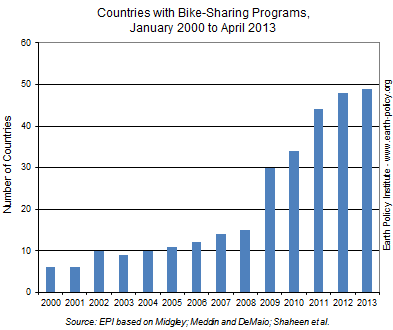Believe it or not, there are bike-sharing programs in more than 500 cities in 49 countries!
That adds up to a world fleet of over 500,000 bicycles, the fastest growth of any mode of transportation in history, urban transport advisor Peter Midgley told Earth Policy Institute.
Back in 1965, Amsterdam was known for its lone bike-share program and it had just 50 bicycles. Many of the bikes got damaged or stolen – they were scattered around the city for free pick-up – and since then cities have adopted more formal programs.
There are 115 miles of bike lanes in Washington DC, including one that travels between the White House and the Capitol. In Copenhagen, there are specially timed traffic lights for bikers and in Hangzhou, China, there are separate bike paths along pretty much all major roads. Many major thoroughfares are closed to motorized traffic every Sunday in Mexico City, opening the roads to some 15,000 cyclists, says Earth Policy Institute.
Forward-thinking cities are encourage bicycling to enhance mobility, alleviate automotive congestion, reduce air pollution, boost health, support local businesses, and attract more
young people. Bike-sharing systems tied to robust transit networks are being embraced by a growing number of people in the urbanizing world who are starting to view
car ownership as more of a hassle than a rite of passage.

Modern bike-share systems incorporate a variety of measures to discourage vandalism. You have to pay by credit card or have a membership to check out a bike in the first place, and the bikes can be monitored using GPS. Also, the bikes used are easily identified specialty models that have unique parts that have limited value to a thief.
Where the Biggest Programs Are
Although the Netherlands and Denmark are known for their cycling cultures, France took bike sharing to another level in 1998, when advertising company Clear Channel began the world’s first public computerized program with 200 bikes in the city of Rennes. In 2015, Lyon, the third largest city in France, began its Vélo’v program with 1,500 bikes at 100 automated self-service docking stations. Bicycling rose 44% in Lyon that first year and then Paris decided to initiate its own program.
Paris’s Vélib launched in 2007 with 10,000 bicycles at 750 stations and as of 2012, there are 224,000 members. There will be 430 miles of trails by next year, all championed by Mayor
Bertrand Delanoë, who says "automobiles no longer have a place in the big cities of our times."
Spain currently leads the world with 132 bike-share programs. Italy has 104, France has 37 and Germany has 43. London is creating bike "superhighways" to double cycling trips and in the Netherlands, the national railroad makes 5,000 bikes available at 240 rail stations and other commuting spots.
Canada got its first program in Montreal in 2009 which now has 5,120 bicycles at 400 stations, and Toronto plans to expand beyond its 1,000 bikes. Vancouver, Calgary, and other cities will start programs in the next couple of years.
Mexico City has the biggest program in Latin America with 4000 bikes, and São Paulo, Buenos Aires, and Santiago, Chile have them too.
In the US, most major cities are considering bike-sharing – the 26 active programs should double in the next year or two.
Capital Bikeshare in Washington DC is the largest so far, with 1,800 bicycles across 200 stations. There are also programs near that size in Minnesota’s twin cities, Boston, Miami Beach and Denver.
New York City’s program will dwarf those with 5,500 bicycles at 293 stations in Manhattan and Brooklyn when it starts next month, with plans to reach 10,000 bikes. Chicago’s program starts in June, and programs will soon launch in Los Angeles (4,000 cycles), Long Beach (2,500), and San Diego (1,800).
In Asia, there are bike share programs in Singapore, South Korea (7000 bikes), and there are 2.1 million bicycle parking spaces in the Greater Tokyo metropolitan area.
But China dwarfs them all with 79 programs supporting a fleet of 358,000 bicycles, which could rapidly expand to a million.

Cities are becoming pedestrian and bicycle-friendly, with ready access to public transit, one of the many factors contributing the decline we’re seeing in gasoline consumption.
++++
This article is excerpted from Janet Larsen’s article for Earth Policy Institute:

Let’s share bikes! It’s a fantastic idea for the environment. I’ve been in both the Netherlands and Denmark and it’s really making a difference.